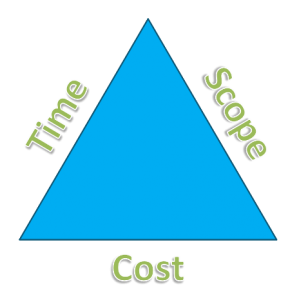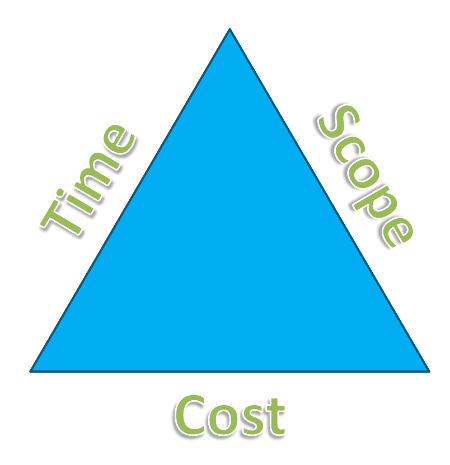 Have you ever heard of the Project Management Triangle?
Have you ever heard of the Project Management Triangle?
You can see it in the image on the right.
But what does it mean?
It means that every project (or goal) is a combination of time, cost and scope.
Broken down further:
- Time – How long will this project take and when do you expect to complete it?
- Cost – How much money do you have to complete the project? Or to invest in it?
- Scope – What is everything that needs to be completed to mark this as a successful project?
For a successful project, you need to have each side of the triangle well defined. And if one edge of the triangle needs to be lengthened or shortened, at least one other side will be affected.
For example, if you need something competed faster you’ll need to decrease the scope or increase the cost. And if you need something done with less cost you’ll need to decrease the scope or increase the time. And if you want more done (increase the scope) you need to increase the time or the cost.
You might be wondering what the heck this has to do with you! You’re a business owner and entrepreneur, not a project manager!
Well, I’d argue you are a project manager. Every goal you have, every strategy you’re using to reach that goal and every to-do list you have is a project or part of a project that you’re managing.
While you don’t need to think about everything in terms of the triangle above, it does help to consider it.
Why? Because it gives your projects (goals, strategies and to-do list) a grounded frame of reference. And generally, one side of the triangle is fixed.
For example, let’s say you want to update your website. You need to start with the fixed side of the triangle. What do you already know about the project? The finish date? The amount you have to invest? The work you want done?
If you know that you want your website completely redone (the “fixed” side is scope), that’s going to be a larger investment in time and money. However, if you have a specific budget to work with (the “fixed” side is cost), that will help determine what will get done now (scope) and the amount of time it will take.
The other great thing about this is the triangle will point out when you don’t have a well-defined project.
Let’s pick a New Year’s favorite of eating healthy. For many people, that’s all there is to their goal (and we know how successful most of them are). If they went through and asked themselves about the cost, time and scope, then they’d have a defined plan.
This is also a good example of how the edges of the triangle move.
Let’s say you want to quickly learn how to eat healthy. Maybe you’re not even sure what the scope of that is, but you know someone who’s a health coach and specializes in this. If you invest your money and a little time in working with her you’ll know exactly what the scope is and have help creating a solid plan.
However, if you don’t have money to invest, you will invest a lot more of your time in determining the scope of the project and create a plan for yourself with more trial and error.
Have you used the Project Management Triangle before, maybe without realizing it? How might you use it in the future? Share in the comments below!





